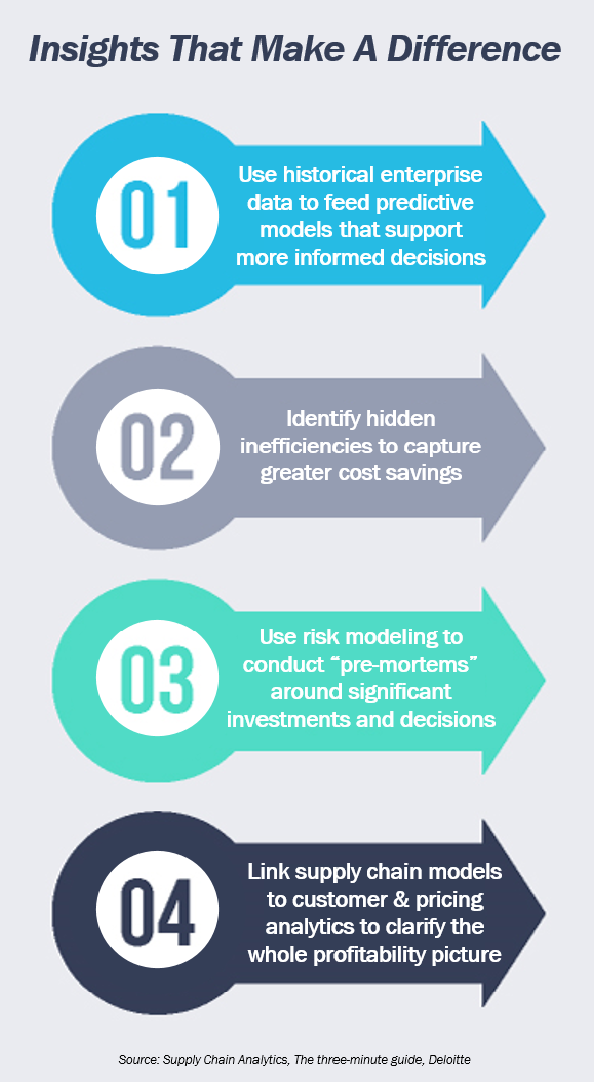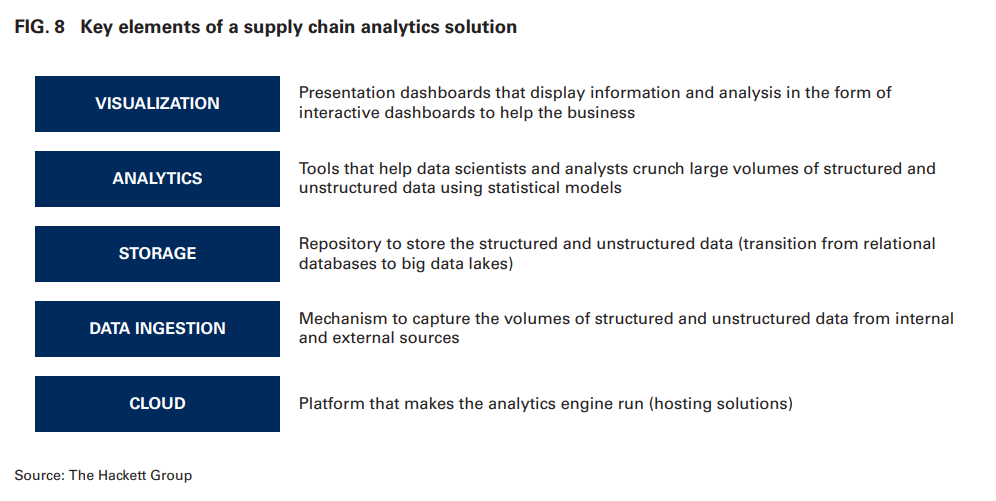The Ledger
Curated content foranalytical business leaders
Tag Archives: supply chain analytics
Reshaping the Last Mile with Agility
The “last-mile” is increasingly becoming a key issue in the e-commerce supply chain. Many companies that struggle are focused on transportation alone, instead of managing inventory and getting the right items to the right place at the right time. The F.A.D. (Flexible transport networks, Automation and Data) model is a framework that will help retailers and logistics operators ensure their competitiveness over the last mile. By improving their performance in increasing automation, managing data and building flexibility into their networks, e-commerce companies in all markets will be able to better manage inventory and increase the efficiency of their last-mile delivery networks.
Gaining Total Visibility in Today’s Supply Chain
In today’s environment of data overload, the overriding challenge companies face is quickly and effectively analyzing the data they pull in. The solution is an industrial-strength data platform that can take device data in, process it, analyze it, and feed business decisions back into processes through apps and automated actions. To gain true value from the data, all data (historical and current) must be integrated and analyzed in real-time to increase responsiveness. With real-time supply chain data, you can go a step further with predictive analytics. A solid data foundation that provides total supply chain visibility can be used to respond to supply chain events faster and even avoid problems with greater predictive power. But more importantly, it can help give you the supply chain agility required to deliver what customers want – and even seize new opportunities faster.
Read More at The Digitalist by SAP >
Digital Supply Chains Never Stop – Especially During Thanksgiving!
Business and supply chains play a large role in most of the things we do, including holidays. Thanksgiving is tomorrow, and while the holiday focuses on family, food, and giving thanks, a tremendous amount of commercial activity goes on behind the scene to make it happen.
“According to one survey, the average consumer spent $165.14 on Thanksgiving tidings last year. You might think the biggest expense is food, but in fact, travel tops the list. More than 46.3 million Americans travel 50 miles or more to join their families, most by car. With Americans spending an average of $67.59 on Thanksgiving Day travel, this category grabs 41% of the spending pie.”
Read More at The Digitalist by SAP>
Your Legacy Supply Chain Systems Are Costing Your Business More Than You Think
Companies still running on legacy, on-premises supply chain technologies are stuck in that linear model and losing their competitive edge faster than they realize. The supply chain model has transitioned from very supply-driven to an end-to-end process that starts with the customer. The focus is now what the customers want and being agile enough to quickly meet the demand. However, shifting to a new business model requires changes to not only the technology being used, but also to the business processes.
Read More at Forbes Magazine Online >
The Spooky Truth – How Digital Supply Chains Prepare for Halloween
“Halloween 2018 is upon us, and here in the US – where Halloween is the world’s most commercial – supply chains have long ago swung into gear. Retailers’ anticipation of another strong year is sky-high.”
According to the National Retail Federation (NRF), Americans are spending more than 9 billion dollars to partake in Halloween festivities this year. While that is a lot of spending, it’s not a record. 2018 comes in slightly lower than 2017, which measured at $9.1 billion. Still, it’s very close – which is what supply chain managers like. Predictability is good. Close attention to industry trends year over year can help you prepare. Preparation, however, only goes so far. The reality is faster, more frequent shifts in demand and increasingly complex global supply chains that resist agility. Responsiveness has never been more important.
Read More at The Digitalist by SAP >
Digitize Your Supply Chain to Increase Visibility & Maximize Velocity
We are at the beginning of a new era: the era of the digitized real-time supply chain that is enabled by the rapid digitization that comes with emerging technology. A real-time supply chain involves understanding and predicting what internal users and customers will need right now, even before they themselves recognize that they need it. Response velocity is the next capability that will define competitive survival. Velocity is the ability of an organization to drive working capital rapidly from suppliers through end customers. However, improving velocity requires visibility into all supply chain activities. Visibility allows individuals to see what is going on, and empower these individuals to interpret information and rapidly make decisions in response to data.
Read More at The Digitalist by SAP >
Optimizing Your Supply Chain with External Data
In this digital age, consumers are more demanding and, with e-commerce as a major competitor, empty store shelves are a no-go. By focusing on external data that involves the world around you, organizations are a huge step closer to a more consumer-oriented supply chain. External information from an Australian FMCG consultant partner can give you the opportunity to create a 360-view of your own company and the economy you operate in. And, it gives you the ability to discover where you can add value to your business. Starting with the point-of-view of the customer, you can optimize your entire supply chain.
Read More at The Digitalist by SAP >
Actionable Data is Driving Supply Chain Analytics
The supply chain is a significant component of the cost structure for many companies – and the ability to generate profits depends heavily on whether they have deep understanding of how and why those costs occur. With globalized supply chains, shifting product demands, and fluctuating pricing structures, companies often struggle to expose the real costs of their processes using traditional supply chain execution systems.
Shippers and distributors are constantly refining how data is gathered, incorporated, and utilized to make their transportation efforts more effective. You can look at this site if you need more information on the same. To make smart business decisions, supply chain professionals need to make sure that their data is accurate, timely and accessible.
Why Supply Chain Analytics Matter
Supply chain analytics enables operational efficiency and facilitates data-driven decisions at operational and strategic level. Finance teams spend lots of effort making sure their supply chains adds value, but often struggle with the limitations of spreadsheets to handle the complexities of modeling growth, profitability, inventory turns, and business operations. As the business rules become more complicated, companies are unable to effectively analyze to improve portioning margins and inventory cycles, drill-down to understand the root causes of the results, and perform “what-if” analysis.
Gaining Insights with Advanced Analytics
The best supply chain analytics processes go beyond providing prior performance results and help companies predict potential outcomes. Much of the current interest in this area revolves around better supplier management and establishing supply chain best practices using analytics. A recent guide by Deloitte, Supply Chain Analytics: The three-minute guide highlights why supply chain analytics are important and why it matters now.
Supply chain models are often based on data from past demand, supply, and business cycles, and do not incorporate predictive analytics capabilities. Even top supply-chain performers have struggled with under-performance due to unanticipated demand and lack of visibility in recent years. However, new advanced analytics tools that make it possible to dig deeper into supply chain data in search of savings, efficiencies and insights that can make a real difference.

Some companies rely on analytics to provide insight into their supply chain and highlight the areas that need improvement. Other companies use predictive models to gauge the future business environment might use their data to make important decisions. Visit sites like https://privacera.com/products/centralized-access-control/ for additional guidance on handling your data.
The majority of supply chain leaders have recently cited a sense of urgency for implementing analytics programs for their supply chains. A recent study from The Hackett Group on supply chain trends found that 66% of supply chain leaders say that advanced supply chain analytics are critically important to their supply chain operations in the next two years. Forecast accuracy, demand patterns, product tracking traceability, transportation performance and analysis of product returns are all places where analytics can fill knowledge gaps and provide more insight into the entire supply chain.
There are also many finance and IT teams that think that having a simple visualization tool is sufficient for analytics. However, there is an ecosystem of required technologies that needs to be assembled underneath the visualization tool to perform as a comprehensive end-to-end analytics solution:

Each element of the analytics process – visualization, analytics, storage, data ingestion, and cloud (access) – is critical to evaluating the supply chain and is possible with the right set of tools in place. Additionally, it is critical to have drill-down capabilities to view granular cost driver information and ways to analyze supply chain performance in real-time.
Achieving a Strategic Supply Chain Agenda
At its core, supply chain analytics is about getting away from making decisions based on instinct and past relationships and moving toward more informed decisions. Performance improvements will start to show with a foundation of a strategic supply chain agenda that is driven by specific business goals and outcomes. One thing is for certain: using strong data coupled with an enterprise modeling tool means better visibility, supply chain cost reduction, and better carrier performance.
With ImpactECS, supply chain pros can analyze the entire supply chain and better identify and manage the root cause of costs so they can react appropriately and in a timely manner. Our tool also allows you to change variables anywhere in the supply chain model to see the impact on profitability. Want to learn more about how ImpactECS can help you achieve a strategic supply chain with advanced analytics? Start Here!

